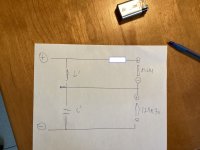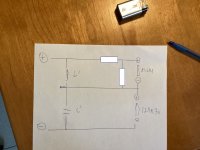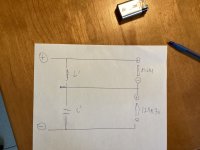If "RT2HA" is your tweeter, then this is a series crossover and you'd put the tweeter pad resistor in series between tweeter + and the node with it's low-pass shunting coil.
Can you draw the position of the tweeter on my xo?
im not exactly sure what you mean
it seems i only understand once its drawn on the schematic…
thx!
im not exactly sure what you mean
it seems i only understand once its drawn on the schematic…
thx!
As you have a very good source and a very transparent tweeter, since you find the exact R value with simple cemented wirewound resistor, you can try something with more resolution for the R before the tweeter like Mundorf Supreme resistor or better a Visay Powertron (the bulk they make for Mundorf as well).
I do not advice the Mills that are veiled and colored to my ears though, here I prefer a classic cement over that one.
Just 2 cents
I do not advice the Mills that are veiled and colored to my ears though, here I prefer a classic cement over that one.
Just 2 cents
apparently, ive been told this is a mistake?Here is the series crossover I have used in my system for idk, 6-9 months. Note the position of the 8R2 resistor. That is the tweeter padding resistor, it can be adjusted to taste.
this is what ive been answered:
"
Capacitor in parallel with woofer.
Resistor in series with tweeter.
Inductor across tweeter + resistor.
"
can someone draw this on my shcematic?
You also have the option to use an L-pad in this position (one more resistor across the tweeter in this case). Predicting what this will do exactly is difficult, but if you try the series resistor and don't like the result, it presents you with another course of action before needing to run simulations.


ive been told L-pad would be less ideal for the amp load
can you write in my schematic just exactly how to put the resistor in series?
can you write in my schematic just exactly how to put the resistor in series?
An L-pad can be used to make the tweeter act like it is a higher or lower resistance if you wanted. Using just a resistor in series gives you the highest overall impedance for the same amount of attenuation. There might be slight differences in the way they even out the tweeter impedance variations and this might produce small response differences.


Post #2 below...
https://www.diyaudio.com/community/threads/acoustic-reality-series-xover.355929/
Between L1 and C1 also is a valid position. I would place the resistor there, 4 ohms or higher in value.
I would then place a capacitor on the top line to protect the tweeter better. I know that is now 12dB electrical, but with planars and flat membranes alike, you don't want a DC pulse/large low freq content coming the through the line and damaging it.
L2 is the baffle step coil, and yes, also makes 12dB/octave electrical. But it is required for spectral balance.
https://www.diyaudio.com/community/threads/acoustic-reality-series-xover.355929/
Between L1 and C1 also is a valid position. I would place the resistor there, 4 ohms or higher in value.
I would then place a capacitor on the top line to protect the tweeter better. I know that is now 12dB electrical, but with planars and flat membranes alike, you don't want a DC pulse/large low freq content coming the through the line and damaging it.
L2 is the baffle step coil, and yes, also makes 12dB/octave electrical. But it is required for spectral balance.
thanks Wolf! but i want to stay 1st order.
can someone draw on my schematic this?
"
Capacitor in parallel with woofer.
Resistor in series with tweeter.
Inductor across tweeter + resistor.
"
thanks a lot!
can someone draw on my schematic this?
"
Capacitor in parallel with woofer.
Resistor in series with tweeter.
Inductor across tweeter + resistor.
"
thanks a lot!
Allen showed you a picture, what more do you want?
It is now apparent that you don't know what you are doing to get results that are acceptable and measurable, and reject all but your 1st order endgame. The fact that you don't understand the pending network as simple as it is, means you have homework to do.
I wish you the best...
It is now apparent that you don't know what you are doing to get results that are acceptable and measurable, and reject all but your 1st order endgame. The fact that you don't understand the pending network as simple as it is, means you have homework to do.
I wish you the best...
after seeing this, my desire for a rt2h has re-awakened.............
I looked into 6db + rt2h years ago.
Search for me and rt2h and you can find some blabbings.........
I knew someone that loved the sound.
However, good luck matching to a woofer that will roll off at 6db with a single coil.
It would need to be flat response maybe 2 octaves above crossover point, and not peak up there, and also a flat Z curve (I don't do crossovers or zobels).
Here is another rt2c video (unknown crossover).
here is the rt2ii (same element as rt2h and rt2c).
"I believe I crossed them over at 3,200Hz via 2nd order"
https://www.youtube.com/watch?v=z7HDfWFBVxA
For less than a few watt levels, I'd imagine the big hivis would be hard to beat.
Obviously, cross higher and steeper for much more output..............
I looked into 6db + rt2h years ago.
Search for me and rt2h and you can find some blabbings.........
I knew someone that loved the sound.
However, good luck matching to a woofer that will roll off at 6db with a single coil.
It would need to be flat response maybe 2 octaves above crossover point, and not peak up there, and also a flat Z curve (I don't do crossovers or zobels).
Here is another rt2c video (unknown crossover).
here is the rt2ii (same element as rt2h and rt2c).
"I believe I crossed them over at 3,200Hz via 2nd order"
https://www.youtube.com/watch?v=z7HDfWFBVxA
For less than a few watt levels, I'd imagine the big hivis would be hard to beat.
Obviously, cross higher and steeper for much more output..............
Last edited:
I absolutely agree that i have homework to do. but i dont know what literature to read.Allen showed you a picture, what more do you want?
It is now apparent that you don't know what you are doing to get results that are acceptable and measurable, and reject all but your 1st order endgame. The fact that you don't understand the pending network as simple as it is, means you have homework to do.
I wish you the best...
I dont pretend to be a know it all. i know nothing at all in understand electrical circuits....
I already have a great system and right now am trying to build a great 2 way speaker mating a 12" to a planar first order
cheers
Last edited:
12br70 seem nice match with rt2haafter seeing this, my desire for a rt2h has re-awakened.............
I looked into 6db + rt2h years ago.
Search for me and rt2h and you can find some blabbings.........
I knew someone that loved the sound.
However, good luck matching to a woofer that will roll off at 6db with a single coil.
It would need to be flat response maybe 2 octaves above crossover point, and not peak up there, and also a flat Z curve (I don't do crossovers or zobels).
Here is another rt2c video (unknown crossover).
here is the rt2ii (same element as rt2h and rt2c).
"I believe I crossed them over at 3,200Hz via 2nd order"
https://www.youtube.com/watch?v=z7HDfWFBVxA
For less than a few watt levels, I'd imagine the big hivis would be hard to beat.
Obviously, cross higher and steeper for much more output..............
I would not, but I've been there done that.
But I will not naysay on your fun / learning.
If you like it, go for it.
You will probably burn out that hivi trying to keep up with the 12".
700hz and up looks to be 95db, louder than either hivi.
Personally, I'm sweet on the SB17NBAC35-4 (listen to a close brother of it every night), but you'd need a resistor and cap change to match it. And the SB has some scary peaks up there, probably best to cross under 3khz and steep.
I've been drawn to the peerless ne180w-4, but they are unobtanium and you'd need to notch that 5khz peak way up, it would zip around a single coil crossover I'd imagine.
Maybe run a tmm using its available 8ohm brother (wired in parallel), again, you'd need to notch the 5khz.
Even then, I hope you are using a 10 band eq, otherwise passive baffle step compensation would be nice.
Perhaps some others with waaaaaayyyyyyyyyyy more crossover knowledge can help, but most of them are not 6db slope fans..........
I will say, I'm not as obsessed with 6db time/phase crossovers as I was before...............
But I will not naysay on your fun / learning.
If you like it, go for it.
You will probably burn out that hivi trying to keep up with the 12".
700hz and up looks to be 95db, louder than either hivi.
Personally, I'm sweet on the SB17NBAC35-4 (listen to a close brother of it every night), but you'd need a resistor and cap change to match it. And the SB has some scary peaks up there, probably best to cross under 3khz and steep.
I've been drawn to the peerless ne180w-4, but they are unobtanium and you'd need to notch that 5khz peak way up, it would zip around a single coil crossover I'd imagine.
Maybe run a tmm using its available 8ohm brother (wired in parallel), again, you'd need to notch the 5khz.
Even then, I hope you are using a 10 band eq, otherwise passive baffle step compensation would be nice.
Perhaps some others with waaaaaayyyyyyyyyyy more crossover knowledge can help, but most of them are not 6db slope fans..........
I will say, I'm not as obsessed with 6db time/phase crossovers as I was before...............
Last edited by a moderator:
I could be wrong, but the rt2h looks like a 7ohm load, pretty flat.
Single cap, for a -3db @ 3,500hz, = 6.5uF
I had luck matching up (approximately) 2 drivers 6db down at 2khz.
-3db@3.5khz may be close enough for a -6db@2k ..............
https://www.audiosciencereview.com/...-designing-line-level-high-pass-filter.27443/
"-3dB freq is just 1/(2*pi*RC)"
https://www.v-cap.com/speaker-crossover-calculator.php#firstOrderCalculator
http://www.apicsllc.com/apics/Misc/filter2.html
Remember, it will be easy to melt this basically $100 tweeter.
Single cap, for a -3db @ 3,500hz, = 6.5uF
I had luck matching up (approximately) 2 drivers 6db down at 2khz.
-3db@3.5khz may be close enough for a -6db@2k ..............
https://www.audiosciencereview.com/...-designing-line-level-high-pass-filter.27443/
"-3dB freq is just 1/(2*pi*RC)"
https://www.v-cap.com/speaker-crossover-calculator.php#firstOrderCalculator
http://www.apicsllc.com/apics/Misc/filter2.html
Remember, it will be easy to melt this basically $100 tweeter.
- Home
- Loudspeakers
- Multi-Way
- Help?

